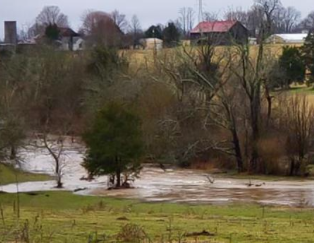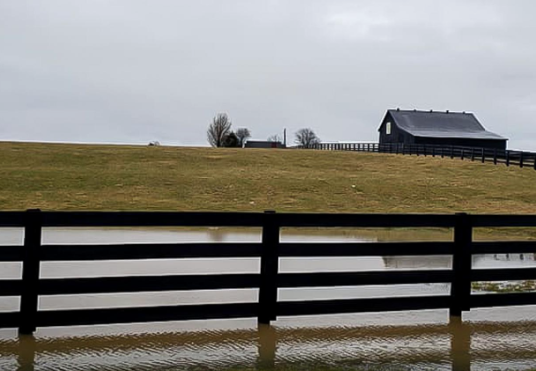By Aimee Nielson
University of Kentucky
Agricultural land in the Bluegrass state is saturated with abundant rainfall from recent weeks. A new system threatens to drop 3 to 5 inches on top of soaked pastures, creating more problems for farmers who are already facing weather-related challenges with nutrition and overall animal health.

February rains wreak havoc on already satruated Kentucky pastures. Photo by Aimee Nielson
“Unfortunately, more rain is on the way,” said Matthew Dixon, agricultural meteorologist for the University of Kentucky College of Agriculture, Food and Environment. “The entire state is under a flood watch that will last into the morning of Feb. 21.”
These conditions are not new to Kentucky’s livestock producers with record-setting precipitation over the past year. Dixon said the current system is poised to come in waves throughout the week and into the weekend with rainfall moderate to heavy at times.
Low-lying areas will be the most vulnerable, but all pastures are soaked at this point and can present difficulties.
He said flooding is likely. Some area rivers are already under flood warnings and any additional rainfall this week will only worsen the problem.
“Anytime producers can know in advance of potential flooding conditions, it gives them a chance to prepare their animals,” said Bob Coleman, UK equine specialist. “It would be wise to move livestock in low-lying areas to higher ground as a precaution. It’s also a good time to make sure you have enough feed supplies so that animals do not get cut off due to unexpected flooding.”

Central Kentucky pastures can’t hold any more rain. Photo By Aimee Nielson
Based on data from the UK Ag Weather Center, Kentucky has averaged 5.27 inches of rainfall for the month, through Feb. 18.
“This is nearly 3 inches above normal for that time span,” Dixon said. “Putting it into perspective—5.27 inches would place Kentucky within the top 15 wettest Februarys on record going back to 1895.”
The all-time record for February was 1989 with 9.85 inches. February 2018 was the second wettest on record with 8.95 inches.
“The bottom line is that it will be back-to-back years of exceptionally wet Februarys and all the challenges that come with that,” Dixon added.
Muddy conditions contribute to many problems including trampled pastures that reduce the opportunity for animals to efficiently graze stockpiled forages, and lameness and foot rot from bacteria lurking the saturated soil.
UK beef specialist Jeff Lehmkuhler said producers had to start feeding hay earlier than normal this winter.
“In many cases, hay quality was reduced due to hay harvested at mature stages or from mold that grew from bailing hay that was too wet at baling time,” he said. “When you look at Mesonet data for Franklin County for example, from Nov. 1, 2018, to Feb. 18, 2019, precipitation was recorded 50 of those 110 days. Cows with wet hair coats have greater energy needs to maintain their core body temperature when air temperatures drop below 55 degrees Fahrenheit.”

February rains piling on already soaked pastures. Photo by Aimee Nielson
With rain nearly every other day, cows have had increased nutritional needs from walking around with wet coats and having to navigate muddy pastures.
“Anything you can do to lessen the muddy conditions for your animals will help,” Coleman said.
“Concrete pads around feed areas are ideal so animals will have a dry place to stand while they eat and drink.”
Aimee Nielson reports for the University of Kentucky College of Agriculture, Food and Environment.






















